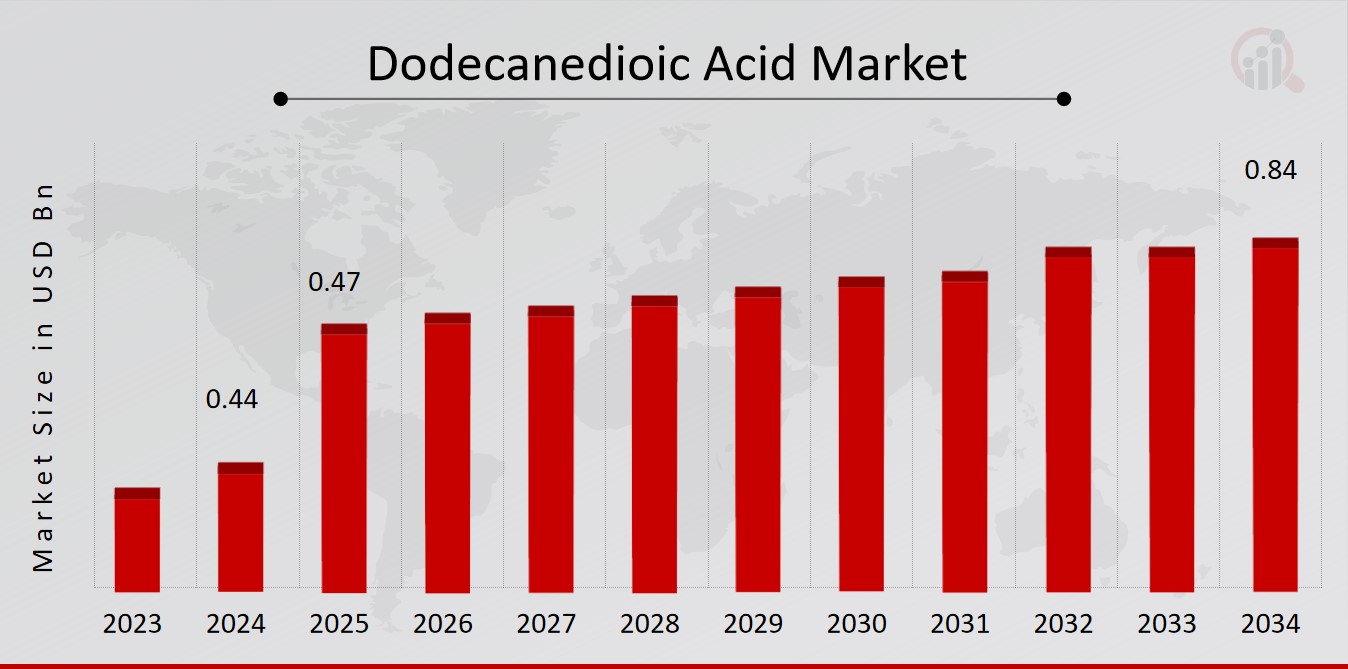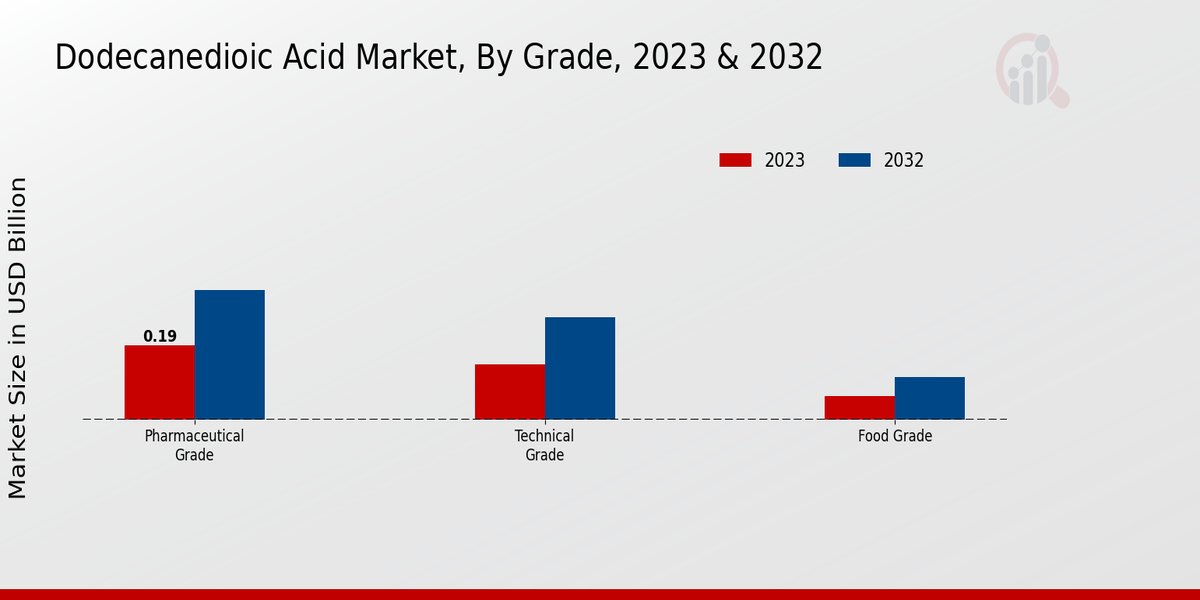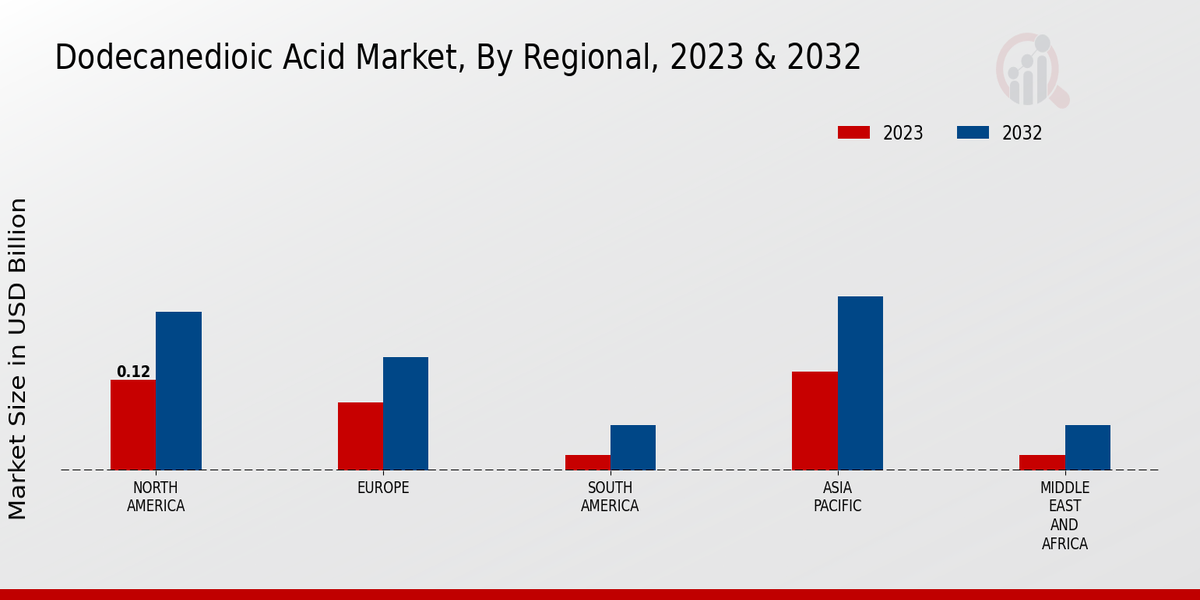Global Dodecanedioic Acid Market Overview
The Dodecanedioic Acid Market Size was estimated at 0.44 (USD Billion) in 2024. The Dodecanedioic Acid Industry is expected to grow from 0.47 (USD Billion) in 2025 to 0.84 (USD Billion) by 2034. The Dodecanedioic Acid Market CAGR (growth rate) is expected to be around 6.73% during the forecast period (2025 - 2034).
Key Dodecanedioic Acid Market Trends Highlighted
Key market drivers for dodecanedioic acid include rising demand for the production of nylon-12, which is widely used in engineering plastics, automotive parts, and consumer goods. Additionally, the growing use of dodecanedioic acid as a feedstock in the production of biofuels and lubricants is driving market expansion.
Opportunities for exploration in the dodecanedioic acid market lie in the development of sustainable and bio-based production methods. The adoption of circular economy principles and the utilization of renewable resources can create opportunities for market growth. Furthermore, the expansion into emerging markets and the development of novel applications in industries such as cosmetics and pharmaceuticals are potential areas of opportunity.
Recent trends in the dodecanedioic acid market include the increasing preference for bio-based and sustainable products. Consumers and manufacturers are shifting towards more environmentally friendly options, creating a demand for dodecanedioic acid produced from renewable sources. Additionally, advancements in catalytic technologies have improved efficiency and reduced the environmental impact of dodecanedioic acid production, making it more competitive in the market.

Source: Primary Research, Secondary Research, MRFR Database and Analyst Review
Dodecanedioic Acid Market Drivers
-
Rising Demand for Bio-based Chemicals
The key driver of the dynamic growth of the Dodecanedioic Acid Market Industry is the expansion of the market for bio-based chemicals. In this context, dodecanedioic acid is a versatile chemical intermediate, being used to manufacture a rich diversity of bio-based chemicals, namely bioplastics, bio-lubricants, and biofuels. Thus, the rising importance of environmental concerns and the necessity to disseminate sustainable alternatives to fossil-based chemicals facilitate the expansion of bio-based chemicals, including dodecanedioic acid.
The demand for biodegradable, environment-friendly materials also spurs the expansion of the market of dodecanedioic acid. Particularly, decent quantities of dodecanedioic acid are consumed as a raw material to produce bioplastics, which are biodegradable and compostable materials, contrasting physically with conventional plastics. The expanding size of the pollution impact and escalating regulatory pressures, which impose sophisticated limitations on plastic production and utilization, also act as a restraining factor on the demand for conventional plastics, whereas they can foster the consumption of bioplastics.
Another instance of the demand related to environmental considerations is triggered by the rapidly expanding market of high-performance lubricants. In this case, dodecanedioic acid functions as a base material to produce bio-lubricants. Apart from comparatively standard performance specifications, bio-lubricants are used due to their environmentally friendly character. Finally, the escalating usage of biol-lubricants in the automotive, industrial, and aerospace sectors also stimulates the concentration of dodecanedioic acid.
Increasing Applications in Personal Care and Cosmetics
Dodecanedioic acid is increasingly used in the personal care and cosmetics industry due to its unique properties. It is a versatile ingredient that can be used in a wide range of products, including shampoos, conditioners, soaps, and lotions. Dodecanedioic acid is known for its ability to improve the texture and feel of hair and skin, and it is also used as a thickener and stabilizer in cosmetic formulations. The growing demand for natural and organic personal care products is also driving the growth of the dodecanedioic acid market.
Consumers are increasingly looking for products that are free from harsh chemicals and synthetic ingredients, and dodecanedioic acid is a natural and sustainable alternative to traditional ingredients. Furthermore, the rising popularity of vegan and cruelty-free cosmetics is also contributing to the growth of the dodecanedioic acid market. Dodecanedioic acid is a vegan-friendly ingredient that is not tested on animals, which makes it an attractive option for consumers who are looking for ethical and sustainable beauty products.
Growing Demand from Emerging Economies
The growing demand for dodecanedioic acid from emerging economies is another key driver for the growth of the Dodecanedioic Acid Market Industry. Emerging economies, such as China, India, and Brazil, are experiencing rapid economic growth and urbanization, which is leading to an increase in the demand for consumer goods and industrial products. This, in turn, is driving the demand for dodecanedioic acid, which is used in the production of a wide range of products, including plastics, lubricants, and personal care products. The growing middle class in emerging economies is also contributing to the growth of the dodecanedioic acid market.
As the middle class grows, consumers are becoming more affluent and are demanding higher-quality products. This is leading to an increase in the demand for products that are made with high-quality ingredients, such as dodecanedioic acid.
Dodecanedioic Acid Market Segment Insights
Dodecanedioic Acid Market Grade Insights
The Dodecanedioic Acid Market is segmented by Grade as Pharmaceutical Grade, Technical Grade, Food Grade and others. The Pharmaceutical Grade segment is anticipated to reflect a share, hence dominating the market by 2023 due to the increasing use of dodecanedioic acid in the production of medicines. The Technical Grade segment is expected to exhibit an increased growth rate in the next ten years owing to the growing demand for this product for manufacturing plastics and other products related to the domain. The Food Grade segment is expected to grow at a constant growth rate over the years due to the use of this as a food additive and preservative.
The increasing demand for the product for use in medicines, cosmetics, and food additives is contributing to the growth of the market.

Source: Primary Research, Secondary Research, MRFR Database and Analyst Review
Dodecanedioic Acid Market Application Insights
The application segment is one of the most important in the dynamics of the Dodecanedioic Acid Market. In 2023, Chemical Intermediates was the premier application segment, generating around 45% of the Dodecanedioic Acid Market revenue. The leading position was primarily facilitated by the broad application of dodecanedioic acid as a raw material in the production of nylon-12, polyamides, and other polymers. An important factor that allows the chemical intermediate segment to be the frontrunner in terms of market share is the increasing consumption of such substances in various industries.
At the same time, the Food Additives application segment is also important and captured a notable 20% of the market in relation to year 2023 contribution. The various applications of dodecanedioic acid as a food acidulant, pH adjuster, and flavor enhancer contribute to the stable demand for this substance and determine its irreplaceable position in the food and beverage industry. An important property of DDDA in terms of the food industry is its ability to impart a sour taste and extend the shelf life of products. The share of its application in the Pharmaceutical segment amounted to 15% of the Dodecanedioic Acid market and is contributing significantly.
The increasing importance of its use in the synthesis of active pharmaceutical ingredients to antibiotics, antifungals, and various agents, along with their biodegradability and low toxicity, determine the relative stability of this application. The Cosmetics segment was the smallest and amounted to approximately 10% of the DDDA market.
Dodecanedioic Acid Market End-Use Industry Insights
The Dodecanedioic Acid Market is segmented by End-Use Industry into Pharmaceutical Industry, Food and Beverage Industry, and Chemical Industry. The Pharmaceutical Industry segment is expected to hold the largest share of the market in 2023, owing to the increasing demand for dodecanedioic acid in the production of pharmaceuticals such as ibuprofen and naproxen. The Food and Beverage Industry segment is also expected to see significant growth, driven by the rising demand for dodecanedioic acid as a food additive and preservative. The Chemical Industry segment is expected to grow at a steady pace, driven by the increasing use of dodecanedioic acid in the production of plastics, lubricants, and other chemicals.
Overall, the Dodecanedioic Acid Market is expected to witness steady growth over the forecast period, driven by the increasing demand from various end-use industries.
Dodecanedioic Acid Market Regional Insights
The regional analysis of the Dodecanedioic Acid Market market reveals distinct market dynamics and growth patterns across key regions. North America emerges as a significant market, driven by the presence of well-established chemical and pharmaceutical industries. The region is projected to account for a substantial share of the market revenue in 2024 and beyond. Europe follows closely, supported by robust demand from the automotive and electronics sectors. The APAC region is expected to exhibit the fastest growth rate, fueled by rapidly expanding economies and increasing demand from end-use industries.
South America and MEA represent promising markets with emerging opportunities for market growth.

Source: Primary Research, Secondary Research, MRFR Database and Analyst Review
Dodecanedioic Acid Market Key Players And Competitive Insights
Major players in the Dodecanedioic Acid Market are focusing on expanding their production capacities to meet the increasing demand from end-use industries. Leading Dodecanedioic Acid Market players are also investing in research and development to develop new and innovative applications for Dodecanedioic Acid, which is expected to drive the growth of the market. The Dodecanedioic Acid Market industry is highly competitive, with several major players holding a significant market share. Some of the key players in the Dodecanedioic Acid Market include BASF SE, Evonik Industries AG, and Merck KGaA. These companies are constantly investing in research and development to improve their production processes and develop new applications for Dodecanedioic Acid. The Dodecanedioic Acid Market is expected to witness significant growth in the coming years, driven by increasing demand from end-use industries such as automotive, construction, and electronics.
BASF SE is a leading chemical company that produces a wide range of products, including Dodecanedioic Acid. The company has a strong presence in the Dodecanedioic Acid Market and is constantly investing in research and development to develop new and innovative applications for its products. BASF SE is also focusing on expanding its production capacities to meet the increasing demand for Dodecanedioic Acid. The company has a reach and operates in over 180 countries. BASF SE is committed to sustainability and is working to reduce its environmental impact.
Evonik Industries AG is a leading specialty chemicals company that produces a wide range of products, including Dodecanedioic Acid. The company has a strong presence in the Dodecanedioic Acid Market and is constantly investing in research and development to develop new and innovative applications for its products. Evonik Industries AG is also focusing on expanding its production capacities to meet the increasing demand for Dodecanedioic Acid. The company has a reach and operates in over 100 countries. Evonik Industries AG is committed to sustainability and is working to reduce its environmental impact.
Key Companies in the Dodecanedioic Acid Market Include
- Symrise
- Oxiteno
- BASF
- EVONIK INDUSTRIES
- Perstorp
- Solvay
- Lonza Group
- Eastman Chemical Company
- Synthomer
- Ashland
- Stepan
- Crod a
- Merck
- DIC Corporation
- Lanxess
- Arkema
Dodecanedioic Acid Market Industry Developments
The Dodecanedioic Acid Market is projected to reach USD 0.84 billion by 2034, exhibiting a CAGR of 6.73% during the forecast period (2025-2034). Rising demand for polyamide 12, particularly in the automotive and electrical & electronics industries, is a key driver of market growth. The increasing adoption of bio-based Dodecanedioic Acid is also contributing to market expansion, driven by growing environmental concerns and sustainability initiatives. Recent developments include the launch of bio-based Dodecanedioic Acid production plants by companies like BASF and Arkema, indicating a shift towards more sustainable and environmentally friendly production processes.
Dodecanedioic Acid Market Segmentation Insights
Dodecanedioic Acid Market Grade Outlook
- Pharmaceutical Grade
- Technical Grade
- Food Grade
Dodecanedioic Acid Market Application Outlook
- Chemical Intermediates
- Food Additives
- Pharmaceuticals
- Cosmetics
Dodecanedioic Acid Market End-Use Industry Outlook
- Pharmaceutical Industry
- Food and Beverage Industry
- Chemical Industry
Dodecanedioic Acid Market Regional Outlook
- North America
- Europe
- South America
- Asia-Pacific
- Middle East and Africa
|
Report Attribute/Metric
|
Details
|
|
Market Size 2024
|
0.44 (USD Billion)
|
|
Market Size 2025
|
0.47 (USD Billion)
|
|
Market Size 2034
|
0.84 (USD Billion)
|
|
Compound Annual Growth Rate (CAGR)
|
6.73% (2025 - 2034)
|
|
Report Coverage
|
Revenue Forecast, Competitive Landscape, Growth Factors, and Trends
|
|
Base Year
|
2024
|
|
Market Forecast Period
|
2025 - 2034
|
|
Historical Data
|
2020 - 2024
|
|
Market Forecast Units
|
USD Billion
|
|
Key Companies Profiled
|
Symrise, Oxiteno, BASF, EVONIK INDUSTRIES, Perstorp, Solvay, Lonza Group, Eastman Chemical Company, Synthomer, Ashland, Stepan, Croda, Merck, DIC Corporation, Lanxess, Arkema
|
|
Segments Covered
|
Grade, Application, End-Use Industry, Regional
|
|
Key Market Opportunities
|
Increasing demand from automotive coatings and electronics industries Growth in biobased production Expansion into emerging markets Rising demand for biodegradable and sustainable materials Technological advancements in production processes
|
|
Key Market Dynamics
|
Increased demand from electronics Growing construction industry Rising disposable income Adoption of biodegradable plastics Expansion of the automotive sector
|
|
Countries Covered
|
North America, Europe, APAC, South America, MEA
|
Frequently Asked Questions (FAQ) :
The dodecanedioic acid market is expected to reach a value of USD 0.84 billion by 2034, exhibiting a CAGR of 6.73% during the forecast period (2025-2034).
The Asia-Pacific region is expected to dominate the dodecanedioic acid market throughout the forecast period, owing to the increasing demand from the automotive and construction industries in the region.
Dodecanedioic acid is primarily used in the production of polyamides, which are used in various applications such as automotive parts, carpets, and clothing. It is also used in the manufacturing of lubricants, plasticizers, and cosmetics.
Some of the key competitors in the dodecanedioic acid market include BASF SE, Evonik Industries AG, Merck KGaA, and Arkema SA.
The growth of the dodecanedioic acid market is primarily driven by the increasing demand from the automotive and construction industries. The rising demand for lightweight and fuel-efficient vehicles is expected to boost the demand for polyamides, which are made from dodecanedioic acid.
The dodecanedioic acid market faces challenges such as fluctuations in raw material prices and intense competition from alternative materials. The volatility in the prices of crude oil and natural gas, which are the primary feedstocks for dodecanedioic acid production, can impact the overall cost of production.
The growing demand for sustainable and environmentally friendly materials presents opportunities for growth in the dodecanedioic acid market. Bio-based dodecanedioic acid, which is derived from renewable resources, is gaining traction as a sustainable alternative to traditional fossil fuel-based dodecanedioic acid.
The dodecanedioic acid market is expected to witness steady growth in the coming years, driven by the increasing demand from various end-use industries. The growing urbanization and industrialization in emerging economies are expected to fuel the demand for dodecanedioic acid-based products.
One of the key trends in the dodecanedioic acid market is the development of bio-based and sustainable production processes. Manufacturers are exploring the use of renewable feedstocks and eco-friendly technologies to reduce the environmental impact of dodecanedioic acid production.
Dodecanedioic acid is expected to find new applications in the future, particularly in the development of advanced materials. It is being explored for use in the production of biodegradable plastics, high-performance composites, and energy storage devices.

















